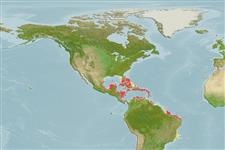Common names from other countries
>
Ovalentaria/misc (Various families in series Ovalentaria) >
Opistognathidae (Jawfishes)
Etymology: Opistognathus: Greek, opisthe = behind + Greek, gnathos = jaw (Ref. 45335); to the very elongate upper jaw of the type species of the genus, Opistognathus nigromarginatus (Ref. 128653).
Environment: milieu / climate zone / depth range / distribution range
Ecologia
marinhas associadas(os) a recifes; intervalo de profundidade 1 - 12 m (Ref. 9710). Tropical; 32°N - 7°N, 95°W - 59°W
Western Atlantic: southern Florida, USA and Bahamas to northern South America.
Tamanho / Peso / Idade
Maturity: Lm ? range ? - ? cm
Max length : 14.0 cm TL macho/indeterminado; (Ref. 6937)
Espinhos dorsais (total) : 11; Raios dorsais moles (total) : 14 - 15; Espinhos anais: 3; Raios anais moles: 13 - 14. The dark spot (deep greenish blue in life) of the dorsal fin usually found between the 2nd and 4th or 5th dorsal spines; body densely mottled with dark brown and flecked with blackish; caudal fin and posterior part of dorsal fin are yellow with rows of small blackish spots (Ref. 13442).
Inhabits rock and sand bottoms or the eroding edges of weed beds. Egg mass incubated in mouth of males (Ref. 5521).
Life cycle and mating behavior
Maturities | Reprodução | Spawnings | Egg(s) | Fecundities | Larvas
Are mouthbrooders (Ref. 39363).
Böhlke, J.E. and C.C.G. Chaplin, 1993. Fishes of the Bahamas and adjacent tropical waters. 2nd edition. University of Texas Press, Austin. (Ref. 5521)
Categoria na Lista Vermelha da IUCN (Ref. 130435)
CITES (Ref. 128078)
Not Evaluated
Ameaça para o homem
Harmless
Utilização humana
Warning: mysqli::__construct(): (HY000/1040): Too many connections in /var/www/html/includes/func_getlabel.php on line 46
Can't connect to MySQL database (fbapp). Errorcode: Too many connections
